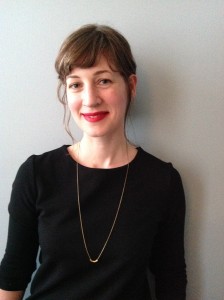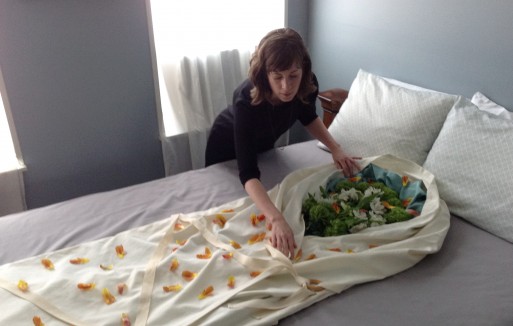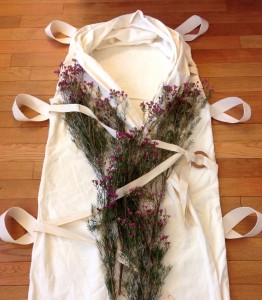Today SevenPonds speaks with Kate Hoover, the founder of Vale Shrouds. Based in Brooklyn, NY, Kate studied sociology at Barnard College and fashion design at Parsons School of Design. She has worked in the garment and publishing industries in various design capacities. After practicing yoga for over a decade, she received her yoga teacher training certification from Integral Yoga in 2011. She studied and volunteered with the New York Zen Center for Contemplative Care from 2012-2014. In the first part of her two-part interview, she discusses the inspiration behind Vale Shrouds, what the process of making burial shrouds entails and whether she offers workshops for those interested.
Zoë: What are shrouds?
Kate: Shrouds are pieces of fabric used to wrap a body in preparation for burial or cremation. They can be as simple as a quilt or long piece of fabric wound around the body, or as elaborate as one’s imagination.
Zoë: What is Vale Shrouds and how did it get started?
Kate: Vale Shrouds is a burial shroud-sewing service that grew out of a contemplative caregiving practice.
In 2012, I began volunteering as a hospital chaplain intern through a contemplative caregiving program. During the program’s training, my classmates and I were asked to spend time considering our own deaths and planning our own funerals. The idea behind this practice was that you can’t really sit in a present way with a patient’s dying unless you have made a good faith effort to face your own.
I became interested in green burial through this assignment to plan my own funeral. I was drawn to the way it preserved green space from development, its simple directness and its lack of waste. I was also drawn to the intimacy and community home ceremonies and caring for one’s dead (for instance washing and dressing the body, decorating a casket) allowed. For me, the relationships I’ve had with people have been the most important part of my life; I couldn’t imagine that not being a part of my death.
The caregiving training culminated in a final project of our choosing, and I decided to sew a green burial shroud for myself. I put my background in sewing and patternmaking into play for the shroud’s construction. I wanted the design to be of the moment — in the spirit of our caregiving training — so I didn’t look at other shrouds; I just sat and wondered what a shroud should do and how to make it do that.
The moment I knew there was something more to keep exploring was when I shared the shroud in our final class show-and-tell. My classmates were (surprisingly) receptive to the shroud, wanting to touch it and ask questions. The mood became almost playful, and they picked me up in the shroud and carried me around in it. To look up and see all these people I cared for around me, it was powerful. It helped me understand how a shrouded burial could encourage involvement and community.
The act of sewing my own shroud was also powerful. As a practice, it went from an abstract discernment — what are the most important people and events to me, what has meant the most to me, what do I value and want to carry with me — to something that became very real and confronting. To see the shroud come together was like watching my mortality become real. However, it was also very life affirming. By defining those things that are important to me, I could make sure to give them more attention with whatever remaining time I have.
To bring us to today and why I kept making the shrouds, people were asking for them and I enjoy making them. A funeral director I met while planning my funeral gave me the feedback to include straps to close the shroud on the top and to include an absorptive layer. Other than incorporating those changes, the design has remained the same as the original one I made for myself.
I also make shrouds for pets. The day I showed the class my shroud, people suggested I also make ones for pets. I searched online to see what was available, and the shrouds I found lacked warmth. So I created a soft bed, something that would fit in a carrier so that it’d be easy to carry the pet home from the vet.
Zoë: What does the process of making burial shrouds entail?
Kate: I approach shroud making as a contemplative practice. That’s how I got started in making shrouds, and I believe it’s important to keep that in play going forward. It’s kind of like how food that’s prepared with love tastes different; my hope is that the intention with which my shrouds are made is transferred into them.
I sew everything myself right now, to keep that connection, that touch. I keep the space quiet and my mind and heart focused on a non-denominational prayer asking for support, protection and care for the deceased and their loved ones. It’s intentionally somewhat vague; I don’t want to put my agenda on anyone. Coming from the hospital contemplative caregiving training, I have a lot of respect for meeting people where they are in their beliefs or non-beliefs. Ultimately, the shroud is about who they are and what they do with it; my prayer is there to hold the space for whatever they want to fill it with.
Right now I offer one main type of shroud: natural cotton/hemp with twill tape straps and wood ring closures. The fabrics and trimmings are all natural and up to green burial requirements. It’s lined with a cotton fleece for absorbing liquids and it has straps for lifting and carrying the body.
The idea is that it’s a blank canvas: a clean design that doesn’t necessarily need anything added and that is timeless. It’s a neutral background so that the flowers and mementos one adds become the focus. At the same time, the design allows for personalization with things like paint or embroidery.
You could pre-order a shroud like the ones I make, and let it rest in your home (it can be stored in a way that will prevent deterioration). You then have the option to either personalize it over time or at time of death. The shroud can, in effect, grow with you.
I can also customize to a degree. If someone has a favorite quilt or fabric, that can be incorporated. If the shroud is going into a casket, the carrying straps may not be a necessity; a shroud can be made without those.
Zoë: Do you offer any workshops for people interested in making shrouds?
Kate: I am putting ideas together right now about forming workshops for people interested in making their own burial shroud. It was such a profound experience for me to sew mine; creating a space for other people to have that experience is something I would love to be a part of. If people are interested, I’d encourage them to reach out to me.
Zoë: Who is usually involved in selecting the shroud? Do you more often find loved ones picking out one for the person who has died or is it more common for someone to choose how they want one made for him or her before death happens?
Kate: Depending on the situation, one finds different approaches. It’s not always possible to have a plan in place ahead of time, and in that instance the choice becomes someone’s other than the deceased. Our culture seems to be moving towards more awareness and openness around talking about death and dying, though, and this has encouraged people to start thinking ahead and choosing things like a shroud or type of ceremony before death happens. This doesn’t always mean it’s a solo project, however; often family and loved ones are involved in the process of choosing a shroud for someone who is dying.
Zoë: What would be the price range for someone interested in purchasing one of your handmade shrouds for the burial of a loved one?
Kate: My shroud can be made with or without carrying straps. With straps, the price is $750; without straps, the price is $550. The additional cost to customize depends on the level of intricacy. (However, incorporating a loved quilt or favorite fabric on the upper side of the shroud is relatively simple.)
Zoë: Do you have any stories that you’d like to share of your personal experiences of creating shrouds and talking to people about shrouds and the important roles they play in green burials?
Kate: There is something comforting about a shroud — that’s an element I didn’t fully appreciate until after I started showing people the shrouds I make. It’s as if the shroud has the power to confer a sense of safety or comfort, and to allow people to open up and share their feelings. I’m not exactly sure what contributes to that feeling of comforting. Maybe it’s that there’s a symmetry of being swaddled at birth and then again being swaddled at death; maybe there’s a connection to our beds where we rest and dream; maybe it’s the softness of the materials coupled with the sturdiness of the design. Whatever it is, I find that people respond to a shroud in a way that is more easeful and emotionally open than I imagine they do to a casket. I am struck, too, by how the ritual of shrouding allows us to have a final moment where we take care of a loved one, and in that way affirm and celebrate the meaningfulness of that relationship.
Kate Hoover’s 5 Ways to Personalize a Shroud:
1) Tuck notes and mementos into the straps or interior. (Note green cemeteries may restrict items to only those that can biodegrade — check with yours).
2) Embroider or paint designs and words (use earth-friendly paints for green ceremonies).
3) Add petals, flowers, grasses, herbs or perfumes.
4) Consult with a shroud maker to incorporate a favorite quilt or other fabric.
5) Sew your own! There are simple, free shroud patterns on cindea.ca.
Zoë: Do you have any advice for our readers interested in learning more about and possibly utilizing a shroud in either their loved ones’ or their own eventual burials?
Kate: Shrouds are versatile. They can be used in green burials either alone or with a biodegradable casket. Placed within a cardboard cremation container or casket, they can be used in cremation and conventional burial, too.
My advice would be that if you are planning a cemetery burial, find a shroud-savvy funeral director. She will be able to point you in the direction of cemeteries accepting shrouded burials. For the most part, the only cemeteries accepting shrouded burials without a casket are the cemeteries listed with the Green Burial Council. Burial requirements vary by state and by cemetery, so it’s good to confirm your plans with your cemetery or funeral director. The Funeral Consumers Alliance has helpful pamphlets on funeral planning and local resources, also. The National Home Funeral Alliance is also an amazing source of information on green burial and shroud use.
I would encourage people to consider making their own shrouds if they have the inclination, too. CINDEA.ca (Canadian Integrative Network for Death Education and Alternatives) has free shroud patterns and a wealth of pre-plan and at-need information (support services, home funeral guides, advance care planning, etc.).
Planning ahead helps to make things less stressful once the time for the ceremony is at hand. Considering these things can be very life-affirming. Defining what is important to you in death often reveals what is important to you in life. The more in advance you look at that, the more time you have to live a life that is in accord with and celebrates your values.
It’s important to talk to your loved ones about their wishes (and your own)! Make sure someone knows where the paperwork is, who the funeral home is and where the shroud is stored. Often people don’t share this information because they think it will make loved ones uncomfortable, but my experience has been that most of us are more open to talking about these things than one would expect.

 What are Burial Shrouds? An Interview with Kate Hoover
What are Burial Shrouds? An Interview with Kate Hoover





 How Dare You Die Now!
How Dare You Die Now!
 Debating Medical Aid in Dying
Debating Medical Aid in Dying
 “Help Me, Helen”
“Help Me, Helen”














